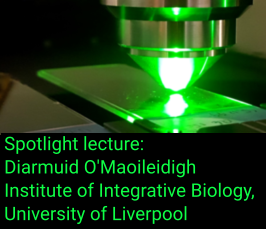Characterization of the activities of a family of miRNAs during floral transition in Arabidopsis thaliana
- Date: Apr 15, 2021
- Time: 03:00 PM (Local Time Germany)
- Speaker: Diarmuid O'Maoileidigh
- present position: Institute of Integrative Biology, University of Liverpool; past position: Post Doc at Max Planck Institute for Plant Breeding Research
- Location: web-talk
- Room: Zoom-Meeting
- Host: Max Planck BioImaging Core Unit Network - Spotlight Talks

Diarmuid O'Maoileidigh will talk about the following publication:
Systematic analyses of the MIR172 family members of Arabidopsis
define their distinct roles in regulation of APETALA2 during floral
transition
Abstract
MicroRNAs (miRNAs) play important roles in regulating flowering and reproduction of angiosperms. Mature miRNAs are encoded by multiple MIRNA genes that can differ in their spatiotemporal activities and their contributions to gene regulatory networks, but the functions of individual MIRNA genes are poorly defined. We functionally analyzed the activity of all 5 Arabidopsis thaliana MIR172 genes, which encode miR172 and promote the floral transition by inhibiting the accumulation of APETALA2 (AP2) and APETALA2-LIKE (AP2-LIKE) transcription factors (TFs). Through genome editing and detailed confocal microscopy, we show that the activity of miR172 at the shoot apex is encoded by 3 MIR172 genes, is critical for floral transition of the shoot meristem under noninductive photoperiods, and reduces accumulation of AP2 and TARGET OF EAT2 (TOE2), an AP2-LIKE TF, at the shoot meristem. Utilizing the genetic resources generated here, we show that the promotion of flowering by miR172 is enhanced by the MADS-domain TF FRUITFULL, which may facilitate long-term silencing of AP2-LIKE transcription, and that their activities are partially coordinated by the TF SQUAMOSA PROMOTER-BINDING-LIKE PROTEIN 15. Thus, we present a genetic framework for the depletion of AP2 and AP2-LIKE TFs at the shoot apex during floral transition and demonstrate that this plays a central role in floral induction.